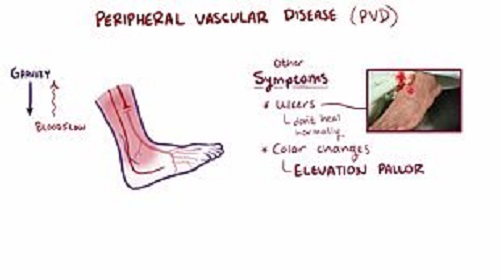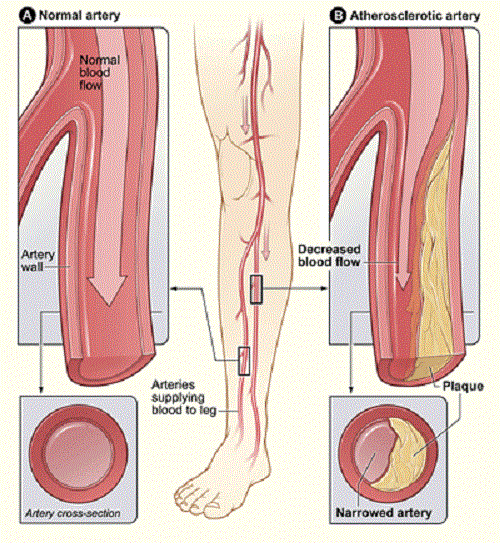Difference Between PAD and PVD

Peripheral vascular disease
Undefined concepts: unraveling the interpretations of Peripheral vascular disease (PVD) and Peripheral arterial disease (PAD)
When we enter the ever-changing world of medicine, sometimes there is a limit to the exhausting order that might rule in all sciences. Some medical doctors would use the term Peripheral Vascular Disease (PVD) ambiguously (1), but according to the American Heart Association (AHA) (2), the first reference worldwide in matters of the cardiovascular system, the classification is the following:
PVD is the general disease, considering the term “vascular” refers to all vessels; there are arteries and veins (big and small) and there is an even smaller microcirculation that connects the arterial circulation that goes, with the venous flow that returns to the heart; the capillary vessels, which are particularly vulnerable to obstruction due to the microscopic size.
There are two types of PVD:
- Functional PVD, like the name says, are vascular diseases that don’t have damage on the structure of the vessel, therefore some are asymptomatic or some may have minor symptoms that aren’t an important threat to a functional life.
- Organic PVD: is when there is a damage to the tissue of the vessel, including rupture or inflammation.
PAD, would be a type of organic peripheral vascular disease (PVD), where there is damage to the tissue of Arteries, common sites are the iliac artery, popliteal (knee) artery and tibial arteries. Obstruction of cardiac arteries (coronaries) is also considered a Peripheral Arterial Disease.
Functional PVD’s Are less common than obstructive organic PDV, and it consists in exaggerated spasms of the vessels that might be caused by:
- Family heritance
- Alterations of the autonomic nervous system, that controls de dilatation and expansion of the vessels
- Legal and illegal drugs that have an action in this autonomic nervous system or directly in the blood vessels
Also, there are 3 well stablished clinical disorders:
- Acrocyanosis: the prefix “acro” means “high” and cyanosis is a clinical sign that consists in the change of color of the skin, to a more bluish tone, due to failures on blood circulation. It is common within women and it is usually triggered by cold or stress. Treatment is frequently not required.
- Erytromelalgia: Erytro (red blood cells related) mel-o, a- (extremities related), algia (pain). This is a rare syndrome that is about heating of the hands and/or feet with moderated pain. Primary erytromelalgia is mostly idiopathic (a fancy medical word to say unknown reasons) but it might be genetical (3). Secondary erytromelalgia is caused by major blood cell disorders.
- Raynaud syndrome: It is a change of color in the fingers or toes, that can turn pale or bluish, the patient might fell numbness and/or tingles. It is also stimulated by cold or stress. It usually affects all the fingers except for the thumbs and toes. To avoid the triggers would be the target of the treatment, and drug therapy is sometimes used.

Illustration: Peripheral arterial disease
Organic PVD’s
The damage on the walls of the vessels mostly is caused by accumulation of fat (atherosclerosis) that progressively can block the blood flow and cause major damage. That block of fat can sometimes travel and cause systemic damage, most common places for this phenomena (Thrombosis) are the iliac veins causing deep vein thrombosis, and the small arteries of the brain causing brain strokes, tough it can also travel to the lungs or small intestine.
Both types of Diabetes (insulin and non-insulin dependent or 1 and 2) increase the risk to develop a peripheral vascular disease due to the systemic nature of Diabetes, that causes a general state of inflammation, dysfunction of the contraction of the muscles in vessels and an overall predisposition to form the fatty blocks that obstructs the bloodstream. This risk can be decreased with early well calculated intensive insulin treatment in type 1 and with a natural flow of blood sugar controlling high peaks and lows. (4)
Any blockage on the bloodstream leaves a site in our organism without the needed nutrients, therefore according to the PVD or PAD’s location, the function of kidneys, lungs, heart, brain, liver or any body organ can be severely damaged.
The treatment consists in the decrease of the risk factors that allows the blockage to happen:
- A balanced diet with regular exercise 3 times a week to combat obesity and the accumulation of bad fat in the blood (LDL -low density lipoprotein- and VLDL -veryLDL-),
Lipoproteins are molecules made of proteins and lipids (fat) that travel around the body to process, transport and store the very needed cholesterol in the organism, bad lipoproteins are the ones that transport the cholesterol to the cells, for vital functions, when there is an excess on LDL the cells stop processing the cholesterol and the fat accumulates in the bloodstream, causing atherosclerosis (that fatty block we now know).
- Smoking cessation
- Controlling diabetes and hypertension
- Specially if we are in the presence of a PAD in the heart, brain or lungs, pharmacologic treatment might be required
In conclusion, the terms peripheral vascular disease and peripheral arterial disease are a widely interchanged, except in the case of a clear blockage of a vein instead of an artery, where the correct etymologically use would be PVD.
So, we only have one difference in this case:
Peripheral Vascular disease logically refer to artery or vein disease, and P. Arterial could only refer to arterial disease. But in the real world, we can find medical doctors who can write PAD in a vein disease. If they get the treatment and evolution right, it will not cost him or her, the job.
- Difference between Fever and Hot Flashes - August 4, 2017
- Difference Between PAD and PVD - June 9, 2017
- Difference Between Melanoma and Carcinoma - May 31, 2017
Search DifferenceBetween.net :
Leave a Response
References :
[0]https://stanfordhealthcare.org/medical-conditions/blood-heart-circulation/peripheral-vascular-disease.html Standford Healt Care
[1]https://www.heart.org/idc/groups/heart-public/@wcm/@hcm/documents/downloadable/ucm_300323.pdf American Heart Asociation
[2]http://emedicine.medscape.com/article/200071-overview#a1 Erythromelalgia Updated: Nov 17, 2016 Author: Antoine N Saliba, MD
[3]http://www.tandfonline.com/doi/abs/10.1080/00015458.2009.11680493 Diabetes and Peripheral Vascular Disease Huysman&C. Mathieu
[4]https://en.wikipedia.org/wiki/Peripheral_artery_disease

